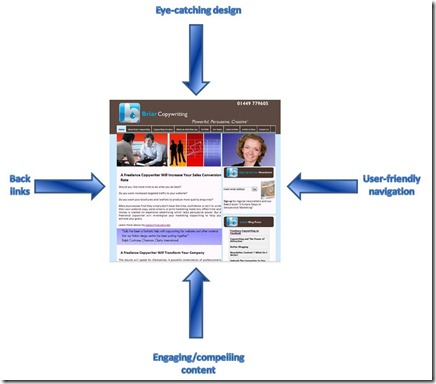Entries from May 2010 ↓
May 19th, 2010 — copywriter, freelance copywriter, search engine optimisation, seo, SEO copywriter

I am a search engine optimisation copywriter (that’s just one of the copywriting services I offer) and so have a good idea about what it takes to get your website ranking well in Google. But there’s more to it that a bit of keyword research and great copy.
There are several factors that have to work together if you are going to get great results:

SEO can be a complex subject, especially if you are new to it all. So, I’ve listed below the 5 basics of search engine optimisation.
1. Keyword research
Before you do anything else, research your keywords. These are the terms real people use to search for your product or service. Although you can guess what people use, there’s no substitute for research:
-
analyse your own Google analytics (this is especially if you already have a website that you are looking for give an SEO make-over to) to see what terms people are using to find you.
-
Do some market research – ask your customers how they found you and if it was through a Google search, what term(s) they used.
-
Social networking – see what people are talking about. Engage with them and ask their advice.
-
Look at what your competitors are doing and what keywords they’re targeting.
-
Don’t overlook local (geographic) terms.
Once you’ve done your research and made a list of primary and secondary keywords, don’t just stop there. You will have to test your keywords constantly to ensure you are targeting the phrases and words that will generate you the most traffic.
2. SEO friendly infrastructure
Before you get to the point of building your website or writing your web copy, you must decide which pages will be used for which keywords. Your Home Page will target your primary words/phrase whereas your sub pages will target your secondary phrases.
3. SEO copy
SEO copy isn’t just the copy that appears on your web pages. You must ensure that your Page title tags use the keywords relevant to that page as identified when looking at your infrastructure.
Then there are your META descriptions. Although these don’t have a direct influence on your SEO, they will have an effect on the number of click-throughs you get. The META description is the text that appears below the page title in your search results page:

By using your keywords within that description, you will show the relevance of your page in relation to the search term and therefore increase your chances of getting that all important click-through. If you don’t add a META description, Google will just take a snippet of text from anywhere on your page. Therefore to ensure its relevance, make sure you provide one.
The next place you need to use your keywords is in your headings – these are the H1 and H2 tags (which go all the way down to H6). Again these are prominent locations which will be picked up by Google. Your primary keywords will go in H1 and your secondary ones will go in H2 onwards. Remember though not to just stuff these areas with keywords. They should be there as part of a meaningful phrase or sentence.
Finally, there’s your website copy itself – if you write naturally the keywords will appear within your text. Whatever you do, don’t be tempted to stuff your copy with keywords. The result will be clumsy and unreadable.
4. Build your links
The final aspect of SEO is link building. The more quality and relevant one way links that point to your site, the higher you’ll appear in the search engine results. Building links should be an ongoing process – there is no quick fix for this. You can generate links in a number of ways:
- Write content for other sites and link back through hypertext links (using your keywords)
- List your website in directories
- Comment on blogs in your industry
- Participate in forums (again linking back to your site by using a link in your signature)
- Write guest blog posts for other people
So they are the basics of SEO. Remember you need to look at everything – your website construction and navigation as well as your copy. All elements have to work together if you want to achieve great results. But this isn’t a quick fix. SEO takes time and constant monitoring – but get it right, and the benefits speak for themselves.
May 17th, 2010 — copywriter, copywriting tips, freelance copywriter, landing pages

Landing pages are used to sell a particular product or service. It is not uncommon to see a company using multiple landing pages that are product specific. Therefore their other marketing efforts (such as email marketing, banner adverts etc.) can be used to target specific people with specific products.
They are highly measurable and can be very effective – when done right.
However, more often than not, they are not used incorrectly and therefore fail to convert visitors into sales. There are many landing pages out there that are just a single page with a call to action and no persuasive copy. It’s as if people assume that just because they clicked through to your landing page, they’re going to buy.
That certainly isn’t the case – you have no idea where they are in buying process; they could be browsing for ideas or just curious. What they will expect is more detailed information to convince them your product is the one to buy.
Therefore when constructing your landing page you must take into consideration the following points:
- What do you want to achieve?
You must decide this before you begin anything. Why do you want to set up a landing page? Are you looking for lead generation, sales, to generate qualified leads for a subscription service or to buy a specific product, or perhaps you’re looking for people to sign up online for a forthcoming event.
If you don’t know who you are trying to attract how do you know what needs to go on your landing page?
Think about the type of person you are looking to attract. What makes them buy? Are they ready to buy yet or are they still researching? Who are your competitors that they’ll also be looking at?
Whatever you write on your landing page, make sure you make a connection with your reader. Use the second person (e.g. you and your) to build rapport. And don’t bore them with details about your company, excite them by telling them what your product will do for them.
You obviously need advertising out there to generate leads to your landing page. Where are they and what form do they take? Are they attracting the right kind of people? Do they motivate people to click through? Is your message strong and clear enough?
Is the copy on your landing page saying the right things? Is it benefit lead? Can your reader see in an instant how beneficial your product is to them? Is your call to action strong enough to make them take action there and then?
All of these points are vital if your landing page is going to be successful. But one key thing to remember is to test every aspect of your page. Set up 2 or 3 pages and drive traffic to them. Which one converts the best? Once you’ve seen what’s working refine it again by setting up more test pages. Test headlines, CTAs, copy, images – test every thing!
Sally Ormond – freelance copywriter
May 14th, 2010 — copywriter, copywriting tips, freelance copywriter, landing pages

A landing page is often a single page website that concentrates purely on one product or service. Traffic is driven to this page through other marketing means – e.g. banner adverts, email marketing, print ads etc.
There are 4 things that need to be considered when creating your landing page.
You have to look at:
- What your offer is going to be?
- Who will be interested in your offer?
- Why they should take further action (i.e. buy or sign up)?
- How do they take further action?
Landing page elements
There are various elements each landing page should have to help answer the above questions.
1. Logo
Your company logo will be on all your marketing materials so your reader can easily identify you. Therefore it should also appear on your landing page to keep the continuity.
Normally it will appear in the top left or top right corner of that page – somewhere it can be seen without detracting from the mail sales message of your page.
2. Unique value proposition
There is one question that will be in the forefront of your reader’s mind when they reach your landing page – ‘what’s in it for me?’ So you must answer it immediately.
Your unique value proposition will tell them exactly why they should do business with you – this will be a major benefit of your product or service.
3. Headline
Because your reader would have come to your landing page from another piece of marketing (email, postcard, banner advert), you must ensure your headline ties in with the advert that generated the lead in the first place. If you don’t you’ll cause confusion and lose the reader.
4. Offer
Whatever your offer is, it must be clear and concise. It is this that will make them make the buying decision (or not) so it has to be a fantastic deal.
But if you make it too complex they’ll walk away. Make sure you keep it simple.
5. Be interesting
The main body of your landing page (or video) has to be interesting. Make sure it is benefits lead so they are left in doubt about what your product/service will do for them. Always write in the second person (i.e. you and your) to build rapport and talk directly to them.
The format of your copy is also very important. Use short paragraphs and sub headings to break up the text. The use of bulleted lists will also add interest.
6. The use of images
Pictures are fantastic if used well. A poor quality or boring image will do more harm than good. Use one that is of high quality and interesting – something that will make them want it.
7. Call to action
This should be simple and commanding and can appear anywhere within the text. Don’t over use it though, there’s nothing worse than seeing a bold CTA after every paragraph – that makes you look desperate.
If the desired action is to complete an online form, make sure it is simple to complete. If your reader is faced with a long and tedious order process, they won’t bother.
8. Create confidence
You have to get your reader to trust you and have confidence in you and your product. Using testimonials, case studies, and reviews will strengthen your case and give peace of mind to your reader. But make sure they are qualified.
9. Be transparent
Don’t hide behind your landing page. If your contact details aren’t prominently featured your reader will think you have something to hide.
Make sure all your contact details are visible along with you T&Cs, privacy policy and copyright details etc. These can be on other pages, but you must make sure a link to them is clearly visible.
10. Test
OK, strictly speaking this isn’t an element that appears on your landing page, but it is vital in its development.
You will never know how your readers will react until you test your page. Create more than one and direct traffic to each one. Check your conversion rates to determine which was more successful. But don’t stop there. Constant testing is the only way to hone the optimum landing page that will convert consistently.
May 12th, 2010 — copywriter, copywriting tips, freelance copywriter, marketing

If there was a single blue print for effective copywriting, I’d be out of a job and all the sales and marketing writing in the world would become predictable and boring.
The structure of persuasive copy is fluid – there isn’t a ‘one size fits all’ solution. So, if you arrived at this post hoping to receive a check-list outlining how to write persuasive copy every time, you’re out of luck.
However, persuasive copy does contain certain elements that crop-up again and again. So without further ado, here are a few pointers to get your copy off the ground.
Elements of persuasive copy
1. Focus on your reader
This is vital and yet there is a lot of copy out there that doesn’t. Your reader is only reading your copy because they think there’s something in it for them. But if you don’t tell them what that is from the outset, they’re not going to keep reading.
Make an impact by giving them an important promise immediately either in the heading or the opening paragraph. Tell them exactly what’s in it for them to get them hooked.
2. Stay focused on your reader
Just because you have them hooked doesn’t mean they’ll finish reading your copy just to please you. Every section of the remaining copy must have a central idea and purpose – don’t waffle. And don’t digress, your copy must always support the main promise you made at the outset.
3. Be specific
Your reader has a built-in BS detector so if you try to pull the wool over their eyes, they’ll spot it a mile off.
The most persuasive copy contains supporting evidence that is specific and qualified.
4. Build credibility
How can you persuade your reader your product is for them? Use statistics, external references, case studies, testimonials etc. These will all build your credibility and show your authority as well.
5. What was in it for them again?
Don’t ever let your reader lose sight of what’s in it for them. Tell them again and again. Reaffirm it with your evidence.
6. Have a stonking offer
By the time your reader has reached here they should be sold on your product. But the offer you make them is going to be key as to whether they buy or not.
7. Sum up
Just as any good Barrister would in a court of law, sum up why your reader should buy. Return to your original promise and show them how you’ve fulfilled it – just in case they missed anything.
8. Call to action
Don’t get all the way to number 7 without adding a strong CTA. By number 7 your prospect will have their hand on their wallet ready to open it. But if you forget the CTA, they’ll just put it back again.
Make it commanding – if you want them to complete an order form make sure it is simple to use. If it looks to complicated they’ll wiggle off your hook and go elsewhere.
So there you go, although there isn’t a set method of writing great copy, by incorporating these elements you’ll get your reader hooked.
Why not give it a go?
May 10th, 2010 — copywriter, copywriting tips, freelance copywriter

One of the best things about being a freelance copywriter, is I get to help other people.
Not just my clients, but other aspiring copywriters.
I receive a number of emails from would-be copywriters looking for hints and tips to help get them started.
They find me either through this blog or through my company website Briar Copywriting.
I love receiving these emails and I always reply to them and give them whatever advice I can. Which is what prompted me to put this post together. Hopefully, I will be able to answer all the common questions in one go.
My journey as a freelance copywriter started in 2007. I was very green back then and was grateful for any advice I could get. So here goes, these are the most frequent questions I get asked:
1. How do I get work?
Yup, that’s always the hard one to answer. Everyone’s background is different. If you have worked as a copywriter within a company and want to go it alone, you’ve probably got potential clients you can approach.
If you are coming into this industry without that leg-up, it’s a bit more difficult. Some copywriters will ‘cold call’ – normally by phone. They’ll contact local companies and try to get work that way.
Another option is to write copy in the hope of attracting clients. For example, if you see sales literature for a company that really isn’t very good, you could re-write it, send it to them and say, if you like it pay me £xxx if you don’t, that’s fair enough.
I was fortunate when I started out. I immediately walked into a paying job and within weeks of setting up, had clients knocking on my door. That isn’t always going to happen though so you’ll have a lot of marketing to do. Get out there and meet people. Go to local networking events to generate a buzz and to get people talking.
2. How do I get a portfolio together?
This is the chicken and the egg scenario – how can you show a perspective client a portfolio of work when you don’t have any clients!
Think about your past work history. What did you do? Can any of that be used to show your writing skills? Even if it’s stuff you did in a voluntary capacity for a local PTA or other organisation, it can still be used. Remember, you are unlikely to be walking in to see large Blue Chip Companies when starting out, so don’t worry about your portfolio looking a bit ‘lame’. You can build on it with every client you get.
3. Is there a copywriting course I should go on?
Let me answer that one this way – I do not have any formal writing qualifications. I have a BA(Hons) in English Language and Literature but I have never taken a copywriting course.
As long as I can remember I’ve always been a writer. And it’s the quality of my work that attracts clients, not the qualifications I hold.
Besides, one thing my clients often say is they like working with me because I bring a fresh take to things. I’m not blinkered to any particular formulas or rules. When I receive a project, I take into account the business, the product, the audience, the media and then create something original that will work for that audience and client.
So, don’t get hung up on thinking you must have a copywriting qualification. Clients will choose you on the quality of your work, not how many letters come after your name.
4. Do I need a website?
Yes!!!!
Your website is going to say a lot about you so don’t scrimp on it. Go to a good web designer (and one who understands SEO) and make sure you get a professional site that is clear, compelling and simple. After all it will reflect your professionalism, your values and your service.
5. Do I need to understand SEO?
Search engine optimisation is essential for your clients and for your business.
It is big business these days and clients are always looking for a copywriter who actually understands SEO. But not only that, you have to understand SEO to get your website ranking well.
My website ranks for all my major keywords. Because of this, I don’t have to go chasing clients. These days clients come to me. They find my website in the search results and commission me – it really can be that easy. Because of this I don’t pay for advertising – my website does that for me.
6. How can I improve my writing?
The simple answer to that one is to write. The more you do it, the better you’ll get. The world of sales and marketing is changing all the time so there is always something new to learn. Plus the more you write the more objective you’ll become towards your own writing so you’ll continuously improve.
You can also improve by reading a lot. Both fiction and non-fiction will help you by exposing you to different styles.
Plus, when you’ve written something for a client, read it out loud. You’ll probably feel a right Charlie, but it will help you identify areas that aren’t working. Make sure you put on your voice-over voice too. Although it will sound very contrived, using intonation and excitement in your voice will help you identify areas that don’t flow because the rhythm is off.
Another way is to watch other writers you admire. Read their work and analyse what they do. This is a great way to pick up tips and ideas that you can transfer into your own work.
7. What else do I need to know?
One of the other essential things you must do is back-up your work constantly.
I have a USB external hard drive that is set to back up my files at certain times. Plus, I also use the Carbonite service which constantly backs up specified files to my Carbonite web space. Once I’ve made an amendment to a file or created a new one, Carbonite waits until it is inactive and then backs it up immediately. I also have a separate portable external hard drive that I regularly back up.
I hope that quick run down has helped answer any question you might have. If you need to know anything else get in touch or make a comment on this post.
Good luck.












